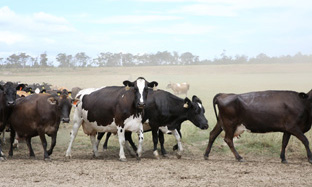
Heartwater Disease in Livestock
Heartwater is a tick-borne disease, which negatively affects the South African livestock industry and is transmitted by the Bont tick (Amblyomma herbraeum)
Symptoms
Symptoms become noticeable in sheep 7-35 days, and in cattle, 9-29 days, after infection. Symptoms include foaming at the mouth, listlessness, high fever and loss of appetite. Animals start to make constant chewing movements, have difficulty breathing, and exhibit a high-stepping gait. Other symptoms include head pressing, lying down with the head pulled backwards and legs stretched out, and padding movements. Fluid builds up around the chest, belly, sac around the heart, lungs, and windpipe of the infected animal.
Lifecycle
The bont tick is a three-host tick, where every stage (larvae, nymph, adult) of the tick feeds on a different animal. The bont tick get infected when it feeds on infected or carrier animals and then transmits the disease to a susceptible animals with their next feeding on second- or third host.
Occurrence
Heartwater outbreaks occur throughout the year, depending on climatic conditions. Bont ticks are mostly found in the Eastern coastal regions of Natal and Eastern Cape, North of Pretoria, in the North–West and Limpopo districts. However, with the movement of animals, the disease has spread, into regions where previously it was unknown.
Treatment
Prevent heartwater disease with regular dipping at set intervals, vaccination, and blocking methods. Treatment should immediately follow diagnosis, with an antibiotic containing oxytetracycline. If an outbreak occurs, isolate infected animals and treat with Terralon LA. Administer supportive treatments to aid in the recovery process. With an outbreak, it is always advisable to contact your local veterinarian to confirm prognoses and treatment protocols.
For more information and assistance regarding Heartwater and the treatment there-off, contact your local Virbac technical sales advisor.

